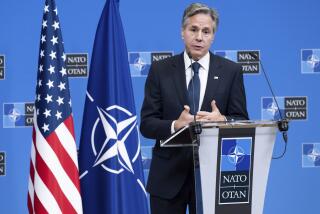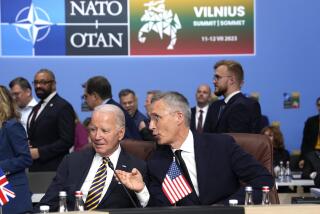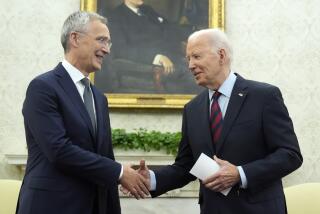NATO Program for Ex-Foes Has Early Payoff
MONS, Belgium — When the United States and its allies begin deploying 60,000 troops for peacekeeping duty in Bosnia in mid-December, the NATO-led force will include several thousand soldiers from six former Warsaw Pact countries, once the war machine of the Eastern Bloc.
The Czech Republic will provide 850 officers and soldiers. The Nordic Battalion will include Estonians, Latvians and Lithuanians. Poland is likely to send some ground forces. And Hungary is offering use of its river ports and airfields as staging areas.
The unusual spectacle--of military units from former Soviet satellites taking part in a North Atlantic Treaty Organization operation--is largely the result of a little-known U.S.-developed program with a kitschy-sounding name: “Partnership for Peace.”
Begun in early 1994 as a way to help democracies emerging from the ruins of the Soviet Bloc build closer ties to the West, the program initially was the object of derision, both among former Eastern Bloc countries themselves and in the West. Countries such as Poland, which wanted to join NATO directly, lambasted the plan as little more than an American ploy to sidetrack their membership and calm Russia’s anxieties about NATO expansion. Few in the alliance thought it would go far.
But now, about 20 months later, the program has undergone a storybook transformation from political frog to diplomatic princess--albeit on a small scale.
All told, about 27 former Warsaw Pact countries and Cold War neutrals such as Austria have joined the program and are becoming active participants in NATO military and diplomatic activities.
Moreover, the program has had some visible impact. Over the past 18 months, partner countries have taken part in NATO planning sessions, conducted exercises with NATO troops and participated in 13 peacekeeping training exercises with U.S. and other allied forces.
NATO meetings in Brussels now include so many high-ranking officers garbed in Soviet-style uniforms that old-timers here often joke that it seems as though the “other side” won the Cold War.
Defense Secretary William J. Perry, who has worked hard to foster the program, credits it with everything from helping to democratize former Warsaw Pact countries to professionalizing their military forces and easing tensions in the region.
In a small but possibly groundbreaking step, Hungary and Romania--enemies for hundreds of years--have quietly developed an exchange for military officers and set up a high-level hot line to help ease tensions caused by suspicion over each other’s military exercises.
Italy and Albania--openly distrustful of each other for years--are conducting joint military training exercises.
Uzbekistan and Kyrgyzstan are establishing a regional peacekeeping unit, modeled after the Nordic Battalion.
And Poland, Hungary, Romania and Bulgaria have begun moving to place their long-independent military establishments under civilian control--a prime requirement for partnership participants who aspire to eventual membership in NATO.
Perhaps the most visible symbol of how far the program has come is its headquarters in Mons, on the sprawling campus of the Supreme Headquarters of Allied Powers in Europe--the nerve center of NATO’s military hierarchy. Here, in a nondescript three-story building that once served as bachelor officers’ quarters are offices of the liaison staffs from partner countries, along with a group of NATO staff officers who help coordinate the program.
Danish army Maj. Gen. Gunnar Lange, director of the partnership coordination cell, says exercises serve as testing grounds for the kinds of educational and planning activities carried out in Mons and at the U.S.-financed Marshall Center, which has offices here.
By almost any standard, Western analysts say, most militaries of the former Eastern Bloc are light-years behind their American and other NATO counterparts--both in their fighting ability and in the way they function in society. Besides obvious gaps in technology and equipment, the majority of partner countries have been using outdated Soviet military doctrine. Their officer corps is elitist, with little contact with ordinary troops. Junior officers and sergeants have almost no responsibility.
U.S. military officers working with partnership forces say their counterparts from the countries of the former Eastern Bloc almost invariably are astounded that American sergeants and corporals are in charge of weapons and equipment that often cost thousands--or even millions--of dollars.
Western military officers say most armies of the nations of the former Soviet Bloc are largely unprofessional, with little incentive for top performance or personal initiative. Few are anywhere near ready to fight alongside NATO forces.
There is no tradition of civilian control, no cadre of knowledgeable civilian bureaucrats and no sense of how to establish a national security strategy, plan the proper kind of force structure and make the case for financing in a parliamentary form of government.
Initiative--even among senior officers--is almost unknown. Western officials involved in dealing with partnership generals find they continuously must make clear that NATO wants the program’s military officers to make decisions on their own, not wait for NATO to do it for them.
There also are wide disparities among countries in the program. Western analysts say Poland, whose armed forces are among the most competent militarily, is far behind in developing its political institutions, while Macedonia--ahead democratically--has a fledgling army.
NATO officials have concentrated most of their efforts on making partner countries more capable of operating with NATO forces--by teaching them Western tactics, procedures and military standards--in peacekeeping, disaster-relief and humanitarian-aid operations. They also have been conducting crash courses in how military establishments function in a democracy, from budget-making to relationships with parliaments. And they have been pushing to get partner armies to become more “transparent”--making their budgets and operations more public.
One of the biggest practical problems the new program has faced has been that so few officers from the former Eastern Bloc speak English--the common language used by NATO for military activities, from planning to ground maneuvers and air strikes. Although the allies have since set up language training, the gap--understandable because the region was so isolated from the West under Soviet domination--has been a serious impediment for some units.
One NATO officer involved in a joint U.S.-Polish training effort last year recalls that the Polish army had so few officers who spoke English that it was forced to “draft” English speakers from the Polish navy and air force and put them in army uniforms for the exercise. A similar language gap exists in military procedures--from radio terminology and the phonetic alphabet (Alpha, Bravo, Charlie, Delta) to map making and report drafting.
There also have been eye-popping cultural clashes. In a recent exercise with U.S. troops, an Albanian army unit started setting up camp around its herd of cattle and goats--a standard procedure in supply-short Albania but anathema to Western sanitation officers. Soldiers from Albania’s cash-strapped army also showed up at their first partner exercises without socks, eventually taking sheets from their bunks at a U.S. Army post and wrapping them around their feet for protection. That problem too has since been corrected.
There also is the matter of women. Although now widely accepted in the U.S. military, women are virtually nonexistent in most partnership armies. Western officers have found themselves adapting to cultural traditions of the former Eastern Bloc--which include kisses on hands and cheeks.
“There were some awkward moments,” recalls one Western officer who watched some unintended gender confrontations between Russian officers and Americans during a 14-country peacekeeping exercise for partnership armies held at Ft. Polk, La., this summer.
By and large, however, Western military units have taken such disparities in stride. “We try to point out the way we do things, without criticizing the way they do them,” says U.S. Army Maj. Sean MacFarland, whose German-based unit has performed joint exercises with partner armies.
The new contact with NATO forces has had an impact on civilians in partner countries as well. Poland welcomed the program’s first exercises in the former East Bloc last year with all the fanfare of a military victory--flag-waving children, a parade, a speech by the prime minister.
In contrast, in rural Transylvania, Romanian peasants were so startled by mock battles involving NATO troops that they warned fellow farmers to prepare for an invasion.
Although the military significance of partnership exercises may be small, officers from former Soviet Bloc nations say the program has had an important psychological impact on foot soldiers and commanders who earlier had been trained to regard Western countries as the enemy.
A recent study showed that 86% of Polish career soldiers consider NATO the best defense option for Poland, compared to 70% two years ago. “We have seen that they [Germans] behave normally, just like any soldier,” says Polish army Lt. Stanislaw Pronczuk.
The response by partner countries to participating in the coming NATO-led peacekeeping operation in Bosnia-Herzegovina has caught some NATO officials by surprise. The Poles and members of the Baltic forces are to operate under command of the U.S. 1st Armored Division, which will head the American contingent. Russian forces also will be part of that group.
“The mission of the Partnership for Peace program is exactly this,” a senior NATO military officer told reporters last week. “It’s come sooner than we thought, but the theory is about to be tested.”
Pine reported from Washington and Hohenfels, Germany; Marshall from Mons and Brussels, Belgium, and Murphy from Warsaw.
More to Read
Sign up for Essential California
The most important California stories and recommendations in your inbox every morning.
You may occasionally receive promotional content from the Los Angeles Times.










